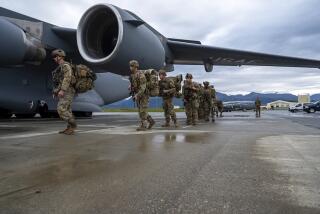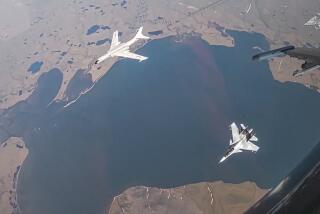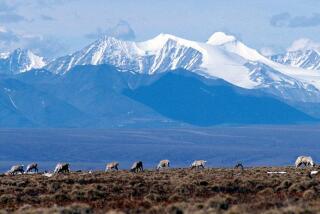Cold War Lives in Alaska Radar Sites
- Share via
TATALINA, Alaska — Time was, 150 airmen and 50 contractor employees crowded this remote mountaintop 240 miles northwest of Anchorage, maintaining the long-range radar that would provide early warning of a Soviet bomber attack.
Now there are only four, all civilians, living in a silver dome and keeping the radar fit for a mission that has all but disappeared.
Not that it’s a bad life. They earn six-figure salaries and work plenty of overtime, and shelter and food are free.
Jimmy Hendricks has spent 20 years working on the North Warning System, and he doesn’t plan to retire anytime soon. He sees his wife in California for perhaps two months a year and spends the rest in this comfortable, out-of-the-way boys’ club.
His wife has never seen his workplace. “She’s not interested. There’s no place to shop,” he says. Hendricks isn’t just the manager of this outpost. He’s also the chef, fixing sandwiches, salads and brownies for his three workmates.
It’s tempting to view the radars as Cold War relics--it’s been three years since a Russian bomber flew close enough to Alaska airspace to prompt an interception by F-15s.
But the U.S. Air Force says the North Warning System’s basic purpose--guaranteeing the security of the airspace over Canada and the United States--still exists.
“NORAD is still charged with the aerospace sovereignty of North America,” said Maj. Robin Alford, a Canadian Defense Forces officer and a spokesman for the North American Aerospace Defense Command in Colorado Springs, Colo. “So whether the Soviets or the Russians are probing our defenses is immaterial.”
Paul Velsko, an electrical technician at the Sparrevohn radar station about 180 miles west of Anchorage, has a different view.
“I don’t think these things are needed anymore. The mission is gone,” Velsko said. “Even when the Air Force was here, it seemed more like a Boy Scout game. The Russians would cross our line, and we’d chase them back, and all the military guys would get excited.”
The Air Force operates 19 sites in Alaska at a cost of about $25 million, down from $117 million in 1985. Across Canada’s arctic coast, 45 other stations also scan the skies.
The Air Force pulled out a decade ago, handing over the stations to a civilian contractor. When airmen were in Tatalina, a metal hut had a basketball court and two automated bowling lanes. Now the stations couldn’t put one full basketball team on the court.
The outline of a ski slope cut into a hillside here still can be seen, but it hasn’t been used for years.
The work can be lonely and dangerous, the men stationed at Tatalina acknowledge. A narrow, steep mountain road leads from the base camp to the radar dome, about 2,000 feet above. Clearing that road of deep drifts, with no guardrail to keep the bulldozer on solid ground, can sometimes be frightening, said Jack Sinclair, an electronic technician with nearly 25 years’ service.
How much longer he and the others will have jobs isn’t clear. The contractor that manages the radar sites along Alaska’s western and northern coasts and in the interior is planning to trim its payroll in the next few years. Some stations will operate with just two people; others will be monitored remotely.
A decade ago the Air Force began installing radio gear to send the radar signals back to Elmendorf Air Force Base in Anchorage, where they are monitored.
For the 56 workers who now live at the radar sites, the talk centers around their job futures.
Life is a routine of maintenance and housekeeping chores. Because the equipment doesn’t break down often, electronic technicians double as cooks and maids. Maintenance specialists seem a little busier, keeping generators and heating systems in good repair.
“You’re never sitting around saying, gee, what am I going to do now?” said Bob Walworth, 50, a mechanic at Tatalina.
When the crew at Tatalina isn’t working, they can take snow machines or four-wheelers to Takotna, a small village on the Iditarod Trail, for some diversion. The stations are stocked with books and music, a pool table, treadmills, weights and television.
At Sparrevohn, a lake a short tundra hike away is loaded with pike and grayling. Wolves, caribou and bear sometimes pass through the 3,000-foot mountains.
The Air Force says the Alaska stations aren’t expected to disappear for several decades, in part because the Federal Aviation Administration also uses them to follow civilian traffic.
Walworth, the mechanic, says he’s as concerned as other radar crew members about the day when their jobs disappear.
Recalling other stations where he’s lived, he said Tatalina compares favorably.
“Sure, I’m looking forward to a vacation, but this site’s a lot better than most. Go up to Cape Romanzof [on the Bering Sea coast]. Most of the guys up there don’t hardly know what to do with themselves.”
More to Read
Sign up for Essential California
The most important California stories and recommendations in your inbox every morning.
You may occasionally receive promotional content from the Los Angeles Times.










